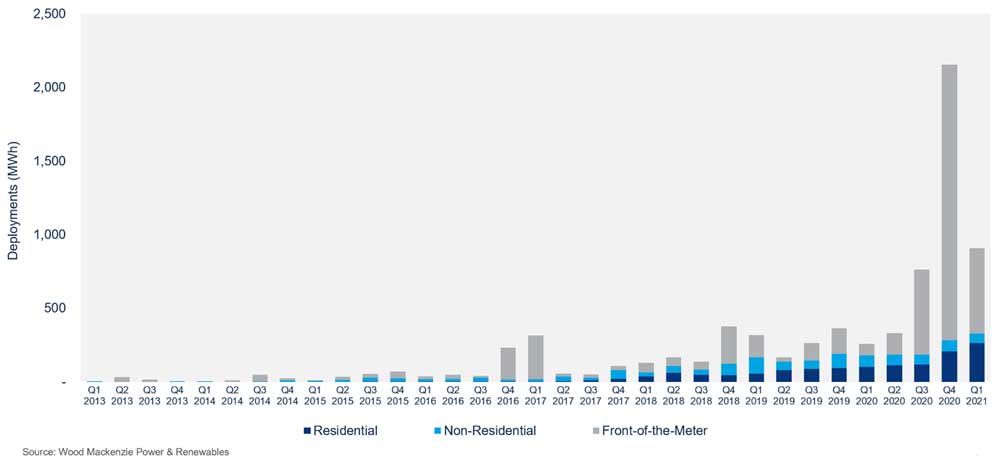Massachusetts — According to Wood Mackenzie and the U.S. Energy Storage Association’s (ESA) latest ‘US Energy Storage Monitor report, 910 megawatt-hours (MWh) of new energy storage systems were brought online in Q1 2021.
This is an increase of 252% over Q1 of last year, making it the biggest Q1 so far for the US storage market.
After a record-setting quarter for deployments in Q4 of 2020, the pace of storage deployments slowed in Q1 2021 in what has come to be somewhat of an annual phenomenon for the industry. However, despite the dip this quarter, the US storage market still notched its third-highest megawatt (MW) total for one quarter.
Looking ahead to the rest of 2021, deployments are expected to accelerate dramatically. Wood Mackenzie forecasts that nearly 12,000 MWh of new storage will be added in 2021, which is three times the amount of new storage added in 2020.
Quarterly US Energy Storage Deployments (MWh), 2013 – 2021

Quarterly US Energy Storage Deployments (MWh), 2013 – 2021. (WoodMac)
One of the most significant storage market developments in Q1 was the introduction of a stand-alone storage investment tax credit (ITC) in Congress. If passed this year, a stand-alone storage ITC would result in a 20-25% upgrade to Wood Mackenzie’s five-year market outlook in megawatt (MW) terms.
Chloe Holden, Wood Mackenzie Energy Storage Analyst, said: “An extra 20 to 25% growth for the US market over the next five years would supercharge an already fast-growing energy storage market. The front-of-the-meter (FTM) segment would see the largest incremental growth, with an extra 6 GW of capacity expected through 2025, which is 25% of our base case market forecast. Without the stand-alone storage ITC, we forecast that the FTM segment will add 3,674 MW in 2021 and 6,915 MW in 2026.”
Jason Burwen, ESA Interim CEO, said: “It’s clear that the energy storage market is poised for tremendous growth in 2021 and beyond. The ‘Storage Decade’ is upon us with the convergence of a transforming power and transportation system, and the growing need for decarbonization and resilience.
“As the leading voice of the US energy storage industry, ESA is thrilled to see more record-setting growth for the industry. This report also provides a timely forecast of how a federal ITC for energy storage currently being considered by Congress would accelerate our market growth trajectory, making realization of our vision of 100 new GW of energy storage by 2030 closer to reality.”
As noted in the report, the US residential storage market set yet another quarterly record in Q1 2021. The market has grown for nine quarters in a row and broke 100 MW deployed in a single quarter for the first time in Q1.
Holden added: “Backup power to complement rooftop solar systems has become the key selling point for residential battery systems in all US markets. Although other states also have growing markets, California will continue to lead the residential segment by a significant margin through 2026.”
The non-residential market (commercial and community-scale) is not seeing the same growth as other sectors, with between 25 and 35 MW of new projects installed in each of the last five quarters.
The report also notes that the FTM interconnection queue now sits at over 200 GW. Though most projects in the queue will not come online, the queue is the largest it has ever been and is a testament to the rapid growth of the US FTM storage market. There is a clear trend of increased geographic diversity of interest in FTM projects, with a surge of interconnection queue requests sitting outside of incentivized markets.












Comments